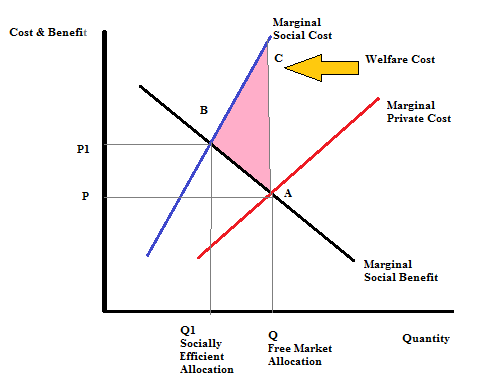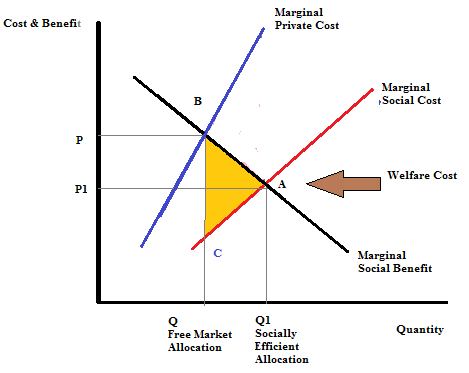Externalities may be defined as the positive or negative effect of a product or process of production, which may affect a stakeholder who is otherwise unrelated to the whole process of production or consumption of the product (Caplan, 2013). One of the simplest examples is air pollution that is caused during the manufacturing process of a product. This air pollution is harmful to society as a whole and may cause serious health hazards. This paper discusses three such externalities – two negative and one positive.
Negative Externality by Chemical and Logging Company
One of the negative externality is the water pollution and logging industry. How may these two companies have a negative impact on the stakeholders? When the manufacturer of a chemical product makes the chemical required in automobile engines. He extracts these from a set of chemicals. Obviously, there is waste that has to be disposed of from this production process. Mostly, manufacturers dump their waste in the nearest water body. This may cause serious damage to aquatic life and to the people using the water body. In the case of a logging company, the logs cut from the forests deplete the natural resources on earth and may lead to climate change. Now let us see how the production process may cause harm to the stakeholders (figure 1).
From figure 1, it is clearly evident in case of a chemical manufacturer the free market equilibrium is attained when marginal social benefit equals marginal private cost at A, which gives an output of Q at price P. However when the external cost of production is added to the figure through the marginal social cost curve, we see that the equality between marginal social cost and marginal social benefits would give us the socially efficient allocation at Q1 and at a higher price P1. The area that charts the difference between the equilibrium points of the socially efficient allocation and the free market allocation shows that there is a loss of welfare due to the difference between the two. This is demonstrated by the pink triangle shown as ABC, marked as the welfare cost. Therefore, this pink area shows the negative cost that the externality causes to the stakeholders.

Therefore, from the analysis, it can be intuitively deduced as the chemical manufacturer produces a large amount of chemical, it also dumps a large amount of chemical waste in the nearest water body, which pollutes it and affects the local people. Two other stakeholders who are affected by the water pollution caused by the manufacturer are the local flora and fauna and aquatic life. Further, the logging company may cause damage to the ecosystem, which overall causes great danger of climate change and affect the human population.
The remedies for such externalities may be manifold (Ayres & Kneese, 1969). For instance, the government may levy taxes on these manufacturers who lead to the pollution of air or water body and the companies that cutaway trees. Such taxes may include carbon taxes or wastage disposal taxes or taxes on cutting trees. Further, in order to throw wastage in the water body or to cut trees by the logging companies, there can be an imposed selling permit, which would become mandatory for them to utilize while engaging in these activities. Another remedy might be the companies are ordered to engage in subsiding the welfare of the affected people. Further, they can be directed to take care of the natural habitat that they were destroying. For instance, the chemical company may be asked to maintain the purity of the water where they dump their waste so that it does not affect harmfully to any living being. On the other hand, logging companies may be asked to replenish the forests before they cut them down.
Positive Externality by Infrastructure Project
Positive externalities are the positive effects that the occurrence of certain economic activity may cause to the life of the people. For instance of the infrastructure project is making roads; this would definitely affect the people of the town positively as there will be less traffic, and commuting would become easier (Hulten, Bennathan, & Srinivasan, 2006). The benefits that commuters would gain due to the construction of the road are a positive externality. The diagram below demonstrates the incidence of a positive externality. When an infrastructure project is undertaken, it helps many people who commute by road as this reduces traffic, traveling time, and ease of traveling.
Hence, these positive externalities are a great benefit to the third party stakeholders. However, the stakeholders who benefit from the externalities are not charged for using the products. The figure shows that the marginal private cost is higher than the marginal social cost, increasing the quantity from Q to Q1, and reducing the price from P to P1. The yellow area in the diagram shows the welfare cost to the company, as the third party users do not pay for the products. The welfare that is gained by the stakeholders and the one that is a loss to the company is shown by the yellow triangle ABC.

References
Ayres, R. U., & Kneese, A. V. (1969). Production, consumption, and externalities. The American Economic Review 59(3), 282-297.
Caplan, B. (2013). Externalities. Web.
Hulten, C. R., Bennathan, E., & Srinivasan, S. (2006). Infrastructure, externalities, and economic development: a study of the Indian manufacturing industry. The World Bank Economic Review 20(2), 291-308.